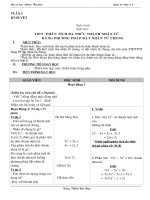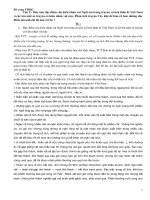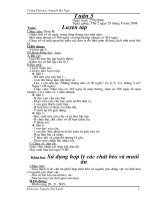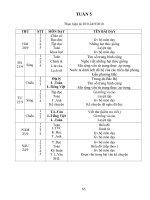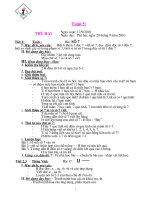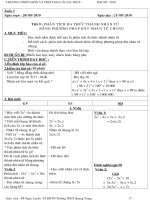5 7 deepwater well control introduction
Bạn đang xem bản rút gọn của tài liệu. Xem và tải ngay bản đầy đủ của tài liệu tại đây (199.54 KB, 15 trang )
Introduction to Deepwater
Well Control
At the end of the lecture, you should be able to:
1. Describe the key aspects of well control in
deepwater operations
1
COPYRIGHT © 2002,
All Rights Reserved
Deepwater well control
•
•
•
•
Define Deepwater Well control?
When can it occur?
Why,how, can it occur?
What are the hazards, risks, probability and
consequence of well control incidents?
• What plans and processes will be used to
manage and control well control incidents?
• Are all aspects “fit for purpose” ?
2
COPYRIGHT © 2002,
All Rights Reserved
Floating vessels
• Vessels movement
– Moored, dynamic positioned
– Operating environment
– Kick detection
• BOP’s located on seabed
– Response time
– Redundancy required
3
COPYRIGHT © 2002,
All Rights Reserved
Deepwater drilling
equipment
• Surface equipment
• Marine riser &
tensioners
• BOP’s
• Subsurface
– Subsea
– Downhole
• Drilling
• Measurement
• Monitoring
4
COPYRIGHT © 2002,
All Rights Reserved
Deepwater operations
• Water depth
– Operating limits and margins
•
•
•
•
•
Well design
Hang off operations
Mud & cement
Hydrates
Routine operations
– Drilling, tripping casing.
– Well intervention
Depth
• Non routine operations
Pressure
5
COPYRIGHT © 2002,
All Rights Reserved
Deepwater special considerations
•
•
•
•
•
•
•
•
•
•
Preparing to kill a well
Well control with bit off bottom
Well control with bit on bottom
Volumetric stripping operations
Kill with no pipe in hole
Circulating gas from riser and BOP’s
Bullheading operations
Shearing pipe
Shallow well control
Lost circulation
6
COPYRIGHT © 2002,
All Rights Reserved
Pore, fracture and mud
pressures
•
•
•
•
•
•
Hydrostatic pressures
Circulating pressures
Formation pressures
Bottom hole pressures
Fracture pressures
Influx and formation
characteristics
7
COPYRIGHT © 2002,
All Rights Reserved
Well control practices
• Leak off & Pressure testing
• Operating and circulating practices
– Pump rate, PVT effects, fluid regimes
• Flow check, influx detection, shut in
methods?
• Behaviour of fluids and gases
• M.A.A.S.P?
• Abnormal, sub-normal pressure regimes
8
COPYRIGHT © 2002,
All Rights Reserved
Kick warning signs
•
•
•
•
•
•
•
•
Hole volumes
Drilled, connection, background gas
Drilling rate
PVT characteristics
Chloride content
Torque and drag
Cuttings size, shale density
3rd party monitoring equipment
9
COPYRIGHT © 2002,
All Rights Reserved
Kick indicators
• Lost circulation
– Mud weight (& effects) > formation pressure
– Extent of Shut in pressures
– Surge pressures
• Well flows
–
–
–
–
Increase of flow (drilling, circulating, tripping)
Pit gain
Drilling break, swab effect, < pump press
Flow from well with pumps off (surge effect)
10
COPYRIGHT © 2002,
All Rights Reserved
Well control equipment
•
•
•
•
•
•
Monitoring and measurement devices
Well containment devices
BOP stack arrangements
Diverter systems
Surface facilities
Subsea systems
11
COPYRIGHT © 2002,
All Rights Reserved
Kill procedures
•
•
•
•
•
Drillers method
Weight and weight method
Bullheading
Volumetric
Dynamic kill
– Shallow gas, water flows
• Contingency
– Blow out and relief well drilling
12
COPYRIGHT © 2002,
All Rights Reserved
Decision trees
•
•
•
•
•
•
•
•
•
Shallow water flow
Shallow gas
Shallow well control
Wellbore stability and ballooning
Lost circulation
Exceeding MAASP
Hydrates
Well kill
Contingency plans
13
COPYRIGHT © 2002,
All Rights Reserved
Deepwater Well Control summary
1.
2.
3.
4.
5.
6.
7.
Operating conditions & environment
Tools and equipment
Special considerations
Pressure management
Warning signs and kick indicators
Planning and processes
Competencies.
14
COPYRIGHT © 2002,
All Rights Reserved
Introduction to Deepwater
Well Control
Now, you should be able to:
1. Describe the key aspects of well control in
deepwater operations
15
COPYRIGHT © 2002,
All Rights Reserved

